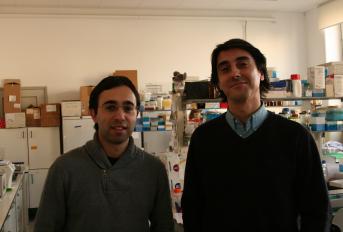Associação Portuguesa de Investigação em Cancro
Nucleolin overexpression in cancer stem cells enables targeted intracellular delivery of synergistic drug combination
Nucleolin overexpression in cancer stem cells enables targeted intracellular delivery of synergistic drug combination

Breast cancer stem cells (CSC) are believed to play a relevant role in tumor growth and relapse, metastization and active evasion to standard chemotherapy, thus representing an important tumor target. The objective of this work was to assess whether nucleolin was a receptor expressed in both breast cancer stem cells and non-stem cancer cells and whether it could be exploited to target nanoparticles-encapsulating drug combinations.
Nucleolin expression revealed to depend on cell pluripotency status, suggesting that nucleolin expression per se could identify highly tumorigenic triple-negative breast cancer cells. In addition, it was shown that nucleolin overexpression in both triple-negative breast cancer stem cells and non-stem cancer cells, mediated targeted intracellular delivery of a synergistic drug combination, enabling 100% cell death.
Overall, it is suggested that nucleolin-based targeted strategies, capable of simultaneous debulk multiple cellular compartments of the tumor microenvironment, may pave the way towards a specific treatment for triple negative breast cancer.
Authors and Affiliations:
Nuno A. Fonseca1,2; Ana S. Rodrigues3,4; Paulo Rodrigues-Santos5,6; Vera Alves5; Ana C. Gregório1,3,7; Ângela Valério-Fernandes1,3,7; Lígia C. Gomes-da-Silva1,2,3; Manuel Santos Rosa5; Vera Moura1,8; João Ramalho-Santos4,9; Sérgio Simões1,2; João Nuno Moreira1,2,*
1 CNC - Center for Neurosciences and Cell Biology, University of Coimbra, Faculty of Medicine (Polo I), Rua Larga, Coimbra, 3004-504, Portugal;
2 FFUC - Faculty of Pharmacy, University of Coimbra, Pólo das Ciências da Saúde, Azinhaga de Santa Comba, Coimbra, 3000-548, Portugal;
3 PhD Program in Experimental Biology and Biomedicine (PDBEB), Center for Neuroscience and Cell Biology, University of Coimbra, Faculty of Medicine (Polo I), Rua Larga, Coimbra, 3004-504, Portugal,
4 Biology of Reproduction and Stem Cell Group, Center for Neuroscience and Cell Biology, University of Coimbra, Faculty of Medicine (Polo I), Rua Larga, Coimbra, 3004-504, Portugal;
5 Immunology Institute, Faculty of Medicine (Polo I), University of Coimbra, Rua Larga, Coimbra, 3004-504, Portugal;
6 Immunology and Oncology Laboratory, Center for Neuroscience and Cell Biology, University of Coimbra, Faculty of Medicine (Polo I), Rua Larga, Coimbra, 3004-504, Portugal;
7 IIIUC - Institute for Interdisciplinary Research, University of Coimbra, Casa Costa Alemão (Polo II), Rua Dom Francisco de Lemos, Coimbra, 3030-789, Portugal;
8 TREAT U, S.A., Parque Industrial de Taveiro, Lote 44, Coimbra, 3045-508, Portugal;
9 Department of Life Sciences, Faculty of Sciences and Technology, University of Coimbra, Calçada Martim de Freitas, Coimbra, 3000-456, Portugal.
Abstract:
Breast cancer stem cells (CSC) are thought responsible for tumor growth and relapse, metastization and active evasion to standard chemotherapy. The recognition that CSC may originate from non-stem cancer cells (non-SCC) through plastic epithelial-to-mesenchymal transition turned these into relevant cell targets. Of crucial importance for successful therapeutic intervention is the identification of surface receptors overexpressed in both CSC and non-SCC. Cell surface nucleolin has been described as overexpressed in cancer cells as well as a tumor angiogenic marker. Herein we have addressed the questions on whether nucleolin was a common receptor among breast CSC and non-SCC and whether it could be exploited for targeting purposes.
Liposomes functionalized with the nucleolin-binding F3 peptide, targeted simultaneously, nucleolin-overexpressing putative breast CSC and non-SCC, which was paralleled by OCT4 and NANOG mRNA levels in cells from triple negative breast cancer (TNBC) origin. In murine embryonic stem cells, both nucleolin mRNA levels and F3 peptide-targeted liposomes cellular association were dependent on the stemness status. An in vivo tumorigenic assay suggested that surface nucleolin overexpression per se, could be associated with the identification of highly tumorigenic TNBC cells. This proposed link between nucleolin expression and the stem-like phenotype in TNBC, enabled 100% cell death mediated by F3 peptide-targeted synergistic drug combination, suggesting the potential to abrogate the plasticity and adaptability associated with CSC and non-SCC.
Ultimately, nucleolin-specific therapeutic tools capable of simultaneous debulk multiple cellular compartments of the tumor microenvironment may pave the way towards a specific treatment for TNBC patient care.
Journal: Biomaterials
Link: http://www.ncbi.nlm.nih.gov/pubmed/26283155




